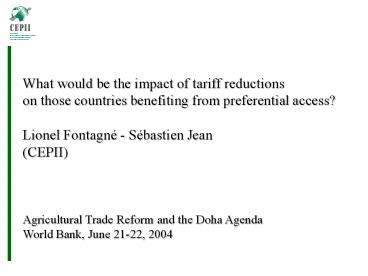Welcome and Introduction - PowerPoint PPT Presentation
1 / 20
Title:
Welcome and Introduction
Description:
on those countries benefiting from preferential access? Lionel Fontagn ... Possible remedies: tailor-made adaptation of SDT; product-specific adaptation of ... – PowerPoint PPT presentation
Number of Views:42
Avg rating:3.0/5.0
Title: Welcome and Introduction
1
What would be the impact of tariff reductions on
those countries benefiting from preferential
access? Lionel Fontagné - Sébastien
Jean (CEPII) Agricultural Trade Reform and the
Doha Agenda World Bank, June 21-22, 2004
2
Why preferences matter
- Agricultural markets are not only highly
protected market access conditions are highly
discriminatory - Trade preferences as substitute for more
ambitious development policies - Tariff instruments combined with quotas allocated
on a discriminatory and non transparent manner - Differential access translates into sizeable
rents - Excessive specialisation of benefiting dvng
countries - Lack of diversification
- Pressure on natural resources
- Vulnerability
3
Illustration
Source MAcMap
4
Political economy issues
- Preferences being used as a development
instrument, their benefits accrue by definition
to the poorest countries - Concern in rich countries regarding the risk of
impoverishment of these economies - A limited number of member countries can block
the negotiation at the WTO
5
Measuring preferences MAcMap
- ITC-CEPII joint work
- Sources source files of TRAINS, country
notifications to the WTO, AMAD, national sources,
Comtrade, BACI-CEPII. - See methodological note for details (Bouët et al.
2004, www.cepii.fr/anglaisgraph/bdd/macmap.htm) - Measures applied duties (incl. exhaustively PTAs)
in 2001 - AV, specific, TRQs ( ADDs separately)
- 147 countries, 240 partners
- Aggregation procedure intended to reflect trade
restrictiveness (not tariff receipts...)
6
Methodology (1) Calculating AVE at the HS-6
level
- Use of HS-6 level trade data Comtrade
harmonisation (BACI database, see www.cepii.fr) - When HS-6 product includes several TL simple
average - Specific tariffs
- ? structural specificities of exports (//
quality, different sub-products, niches, etc.) ?
convert using UV of the exporters reference
group (RG) - use weighted median, instead of average (for the
sake of robustness)
7
Dealing with TRQs
- Source data AMAD
- compute a fill rate for each quota (and for each
(group of) exporter that are ex-ante allocated a
given part of the quota) fill_rate
imports/quota - marginal protection
- IQTR if fill_rate lt 90
- OQTR if fill_rate gt 100
- (IQTROQTR)/2 if 90 lt fill_rate lt 100 (quota
filled, but OQTR prohibitive) - compute the rent, and add it as a separate
information
8
Methodology (3) Aggregation
- Reflect trade restrictiveness
- Across products and exporters weighting scheme
based on imports of the RG the importer belongs
to, instead of the importer himself - Across importers weighting scheme accounts for
the size of the importer, and of the share of the
product in imports of the RG the importer belongs
to
9
Average agricultural protection in selected rich
countries, by partner (AVE, )
10
Summary results MAcMap MFN vs. GTAP 5 in
agriculture
11
Average protection faced, by exporter (AVE, ) -
Agriculture, 2001
- Source MacMap_HS6
12
TRQ rents amount received by exporter (2001 USD
millions)
Source Bouët et al. (2004), based on MAcMap.
13
The "mechanics" of erosion
- The cuts are applied to bound duties
- A new (lower) cap is set for tariffs
- For a given line, the higher the initial tariff,
the deeper the cut - Preferential tariffs are not necessarily cut down
- Preferences are proportionately more eroded than
tariffs are cut
14
Erosion illustrated (1)initial state
15
Erosion illustrated (2)50 cut in the bound rate
16
Erosion illustrated (3)90 cut in the bound rate
17
Erosion in practice(GTAP sector)
Source MAcMap
18
Impact of Harbinsons proposal on average
protection faced, by exporter
(Source Bouët et al., 2004, based on MacMaps_HS6)
19
Impacts on agricultural exports ( changes in
volume)
(Source Bouët et al., 2004, based on MacMaps_HS6)
20
Do "preferred" countries use the preferential
regimes they are entitled to?
- Uncertain because of RoOs, technical
administrative requirements, etc. - What matters is average protection faced in
practice - 3 AVEs computed (Candau et al., 2004)
- MFN
- "Best" (i.e., lowest) preferential duty
applicable - "Requested" average duty levied in practice
21
MFN, requested and best preferential duty in the
EU, Raw ag, 2001 (AVE, )
Source Candau et al., 2004
22
MFN, requested and best preferential duty in the
EU, Food, 2001 (AVE, )
Source Candau et al., 2004
23
Concluding remarks
- Preferences matter, not necessarily on average,
but for some specific (and poor) countries - Imperfect utilisation does not change
significantly the broad picture - Multilateral liberalisation should entail more
than proportionate erosion - Limited amount, well-identified vulnerable
countries (Caribbean, SSA, Mediterranean, LDCs) ?
the problem can be addressed - Possible remedies tailor-made adaptation of SDT
product-specific adaptation of formula
adjustment packages offering new opportunities
(cotton, mode 4...)































